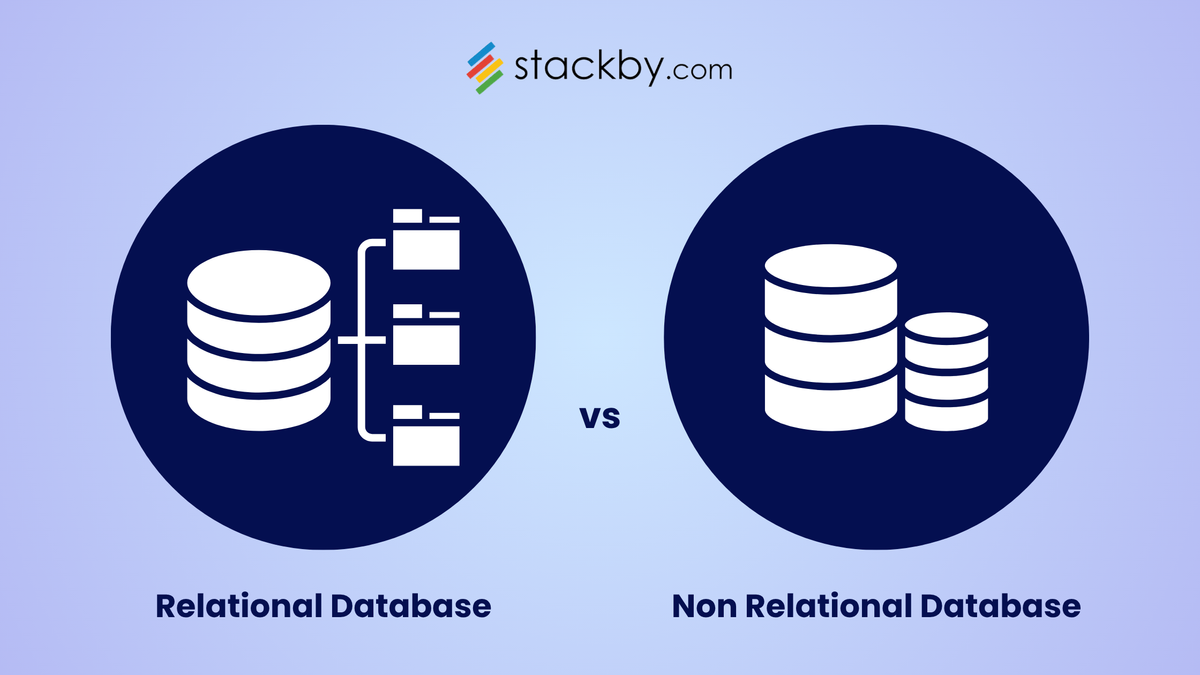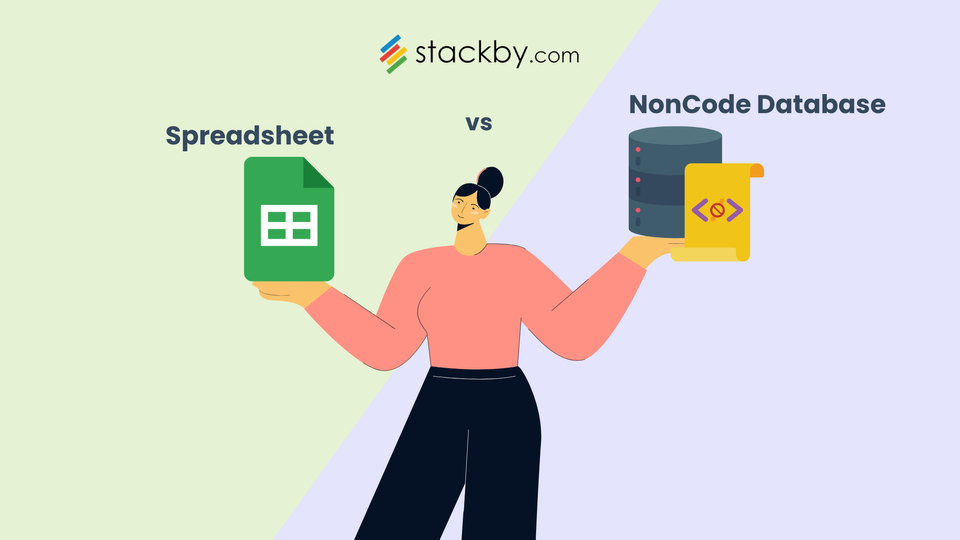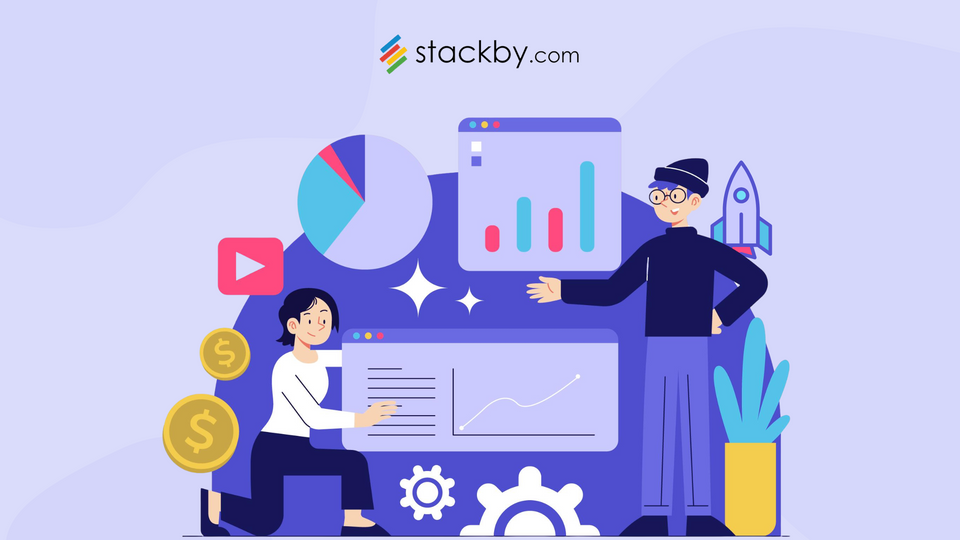Relational vs Non-Relational Databases | What’s the Difference?
Confused between relational and non-relational databases? Discover how they differ, when to use each, and which suits your needs best. From structured tables to flexible NoSQL formats—this guide breaks it all down, including how Stackby offers the best of both.

It's 2025, and data has an influence on almost every business decision today. The kind of database you choose directly determines the performance of your systems, how readily they scale, and what kind of work can be handled easily by your team be it syncing sales reports or running AI-enhanced operations.
But not all databases are equal and fit every use case. And one of the most common decisions teams face early on is choosing between relational and non-relational systems. It might sound like deep tech jargon, but the difference is actually simple than you might expect and key to building smarter systems.
In this blog, we'll explain the basics of relational and non-relational databases, what they are, when to use them, and where Stackby fits in as a modern, no-code relational database tool.
What exactly is a database?
Databases are like a virtual cabinet where your data is kept neatly, is quick to access, and ready to be changed whenever required. These database systems can store different data forms from highly organized tables with numbers and texts to loosely formatted documents.
Choosing the right database should be determined based on your need. Some database software can handle big and complex data easily, while others are best for basic or unchanging information.
It essentially depends on how much data you're handling, how fast you need everything to run, and how complicated the data relationships are. If the database type doesn't match your needs, then it can slow down your app or make database management a mess.
What Are Relational Databases?
A relational database keeps information in organized tables. Each row is a record while each column holds one category or type of information. These tables are linked together through unique keys like primary keys which link records to their details, and foreign keys to join different tables in related rows or columns.This setup lets data reference other tables without being duplicated. That’s why we call it “relational.”
Relational databases aim to keep the information consistent, organized, and easy to track. You need to work with it using SQL, which will help you query, update, and handle the datasets as per your need. It's a solid choice when your data has clear relationships and needs to follow a set structure like customer orders, HR systems, or finance.
What is Relational database ?
Examples of Relational Databases
MySQL, PostgreSQL, Oracle Database, and Microsoft SQL Server are some of the popular options. Industries needing high data accuracy have grown to rely on these systems. Banks, hospitals, and large corporations count on what is a relational database to run their operations
Limitations of Relational Databases
- Scaling Issues: It's difficult to handle massive amounts of data across multiple servers.
- Rigid Structure: It gets challenging to change the data schema later.
- Performance Limits: As datasets start to grow bigger, they can slow down or become tricky to handle.
What Are Non-Relational Databases?
Unlike fixed tables, a NoSQL or non relational database stores data in adaptable forms. Data here is not only confined to rows and columns and can be stored as documents, key value pairs, graphs, or wide column layouts. Because there is no fixed schema, you may change or add to the format as your data changes. Handling fast-moving, unpredictable data like user-generated content or social media feeds is best with this adaptability. It's exactly drawing the structure you require on a whiteboard without thinking about the specifics to fit a box.
Examples of Non-Relational Databases
- Document: Keeps data in document format, like JSON format. Example: MongoDB.
- Key-value stores: Stores data as key-value pairs. Example: Redis.
- Column-family: Organize data in columns making it perfect for big data. Example: Cassandra.
- Graph: Focus on relationships such as those in social networks. Example: Neo4j.
Non relational databases are usually preferred in apps needing speed and flexibility, such as social media platforms, real-time analytics, and Internet of Things (IoT) systems. They use different query languages or APIs instead of SQL, to access data.
5 Reasons Why Your Business Needs a Good Database Management System
Limitations of Non-Relational Databases
- Limited Multi-Document Transactions: Joining data from multiple documents or running transactions across them often proves challenging or lacks support altogether.
- Consistency Concerns: Many of these systems use "eventual consistency," so the most recent data might take some time to reflect.
- More Development Work: Lack of a fixed structure can cause developers to need to include extra logic to ensure the accuracy and dependability of the data.
Primary Differences Between Relational and Non-Relational Databases
Data Structure and Schema Flexibility
Relational databases need fixed tables and strict schemas. They’re like a carefully arranged filing cabinet. Non-relational databases are more like flexible folders, storing documents or key-value pairs.
Scalability
Relational databases mainly scale up (adding resources to one server). They struggle with horizontal scaling. Non-relational systems support scaling out i.e. spreading data across many servers much more easily.
Querying and Transactions
Relational databases provide complex querying options and full ACID compliance, which ensures data accuracy. Non-relational databases often have simpler ways to query.To boost speed and availability, they might relax some rules on consistency. These databases follow the BASE model: Basically Available, Soft state, Eventual consistency.
When Should You Use a Relational Database?
Pick relational databases for clean, structured, and precise data. If your app needs transactions, joins, and a clear schema, a relational database will serve you well.
Ideal For:
- Financial systems
- CRM software
- ERPs
- Healthcare
- E-commerce platforms
- Any project that needs ACID compliance
Here changes happen in a controlled way and you can get a clear picture of how the data will appear.
When Should You Use a Non-Relational Database?
Non-relational databases excel in places where data doesn't fit well into rows and columns. They’re quick to set up, easier to scale, and perfect when your structure needs to evolve.
Ideal For:
- Real-time analytics
- Content management systems
- Social media apps
- IoT applications
- Rapid prototyping or MVPs
If you expect your app to grow fast and change often, or if you're handling massive amounts of unstructured data, then NoSQL or a non relational database turns out to be the better option.
7 best no-code simple database app builders in 2025
Practical Guide For Choosing The Right Database
- Assess Data Type: What do you need? Strict tables or flexible documents?
- Scalability Needs: Will your data grow fast? Do you need to handle large volumes easily?
- Consistency & Transactions: Is precise, real-time data critical? Or is eventual consistency acceptable?
- Team Skills & Tools: Do your developers know SQL well, or do they prefer NoSQL? What tools are already in place?
Tips:
- When data relationships are complicated and precision is paramount, use relational databases.
- Choose NoSQL for rapid growth, unstructured data, or when pace is important.
- Consider a hybrid approach by combining both to get the most out of both.
Where Does Stackby Fit In?
With Stackby, you have the best of both worlds. It enables users to establish relational database structures (linking rows, establishing relationships, building schemas) while maintaining the adaptability found in non-relational no-code platforms. Without needing technical skills to write SQL queries or manage schema migrations, you can build workflows through visual drag and drop interfaces.
In a single platform you can handle complex data relationships while designing custom column types and automating tasks. Stackby offers over 1000 templates alongside 30 column types and 50 native API integrations (via Zapier, Pabbly or Make) to tailor its functionality for effective data organisation.
And now in 2025, Stackby is powered with AI capabilities. By using simple prompts, you can summarize rows, auto-fill entries, generate formulas, classify data among other tasks. This tool transcends simple database construction to become your data co-pilot.
And now in 2025, Stackby is powered with AI capabilities. By using simple prompts, you can summarize rows, auto-fill entries, generate formulas, classify data among other tasks. This tool transcends simple database construction to become your data co-pilot.
Conclusion
Choosing between relational and non-relational databases isn’t about which one is better, rather assessing what you need. Relational databases offer organizational structure and data consistency. Non-relational databases offer adaptability and speed. And tools like Stackby will give you both: control when you need it, freedom when you want it.
So, whether you're growing a business or simplifying your operations, start with what your data demands and then build smarter from there.
Try Stackby for free and build your own custom, no-code relational workflows, powered by automation and AI.

![13 Best Business Management Software for your Work [2026]](/blog/content/images/size/w960/2024/03/stackby-business-blog-image-1.jpg)
![10 Best Free Database Templates for Marketing Agencies in [2026]](/blog/content/images/size/w960/2024/03/stackby-Database-templates-for-marketing-agencies-1-blog-post-2.jpg)

